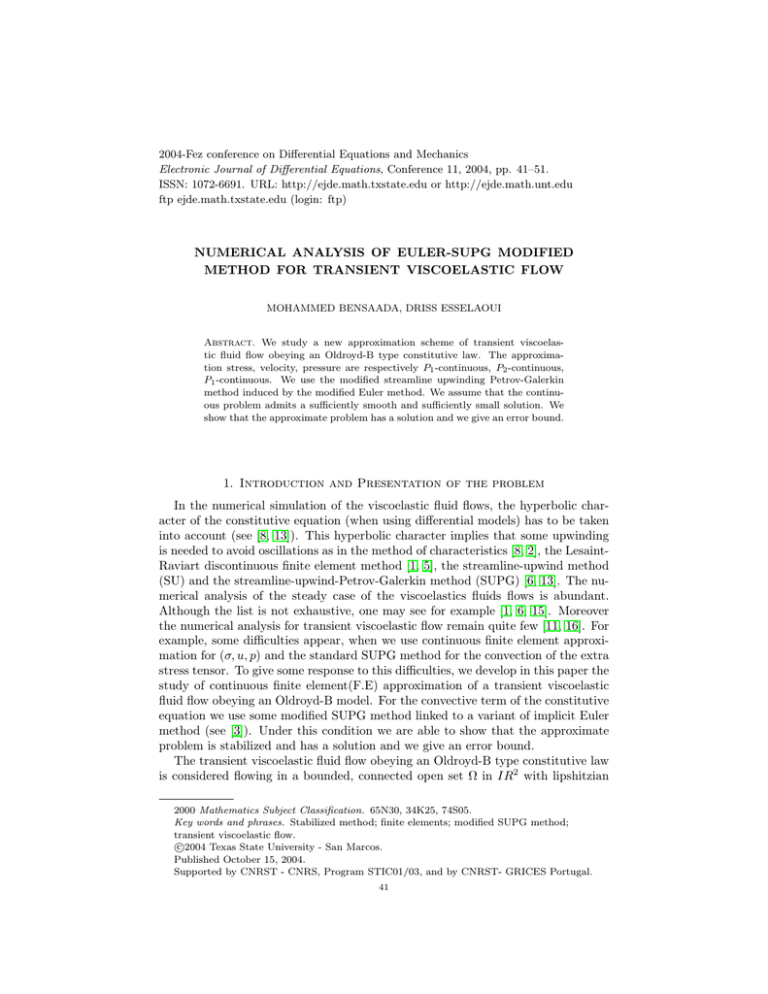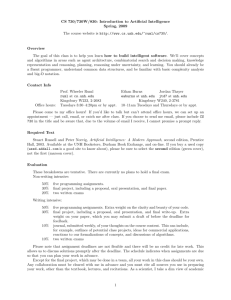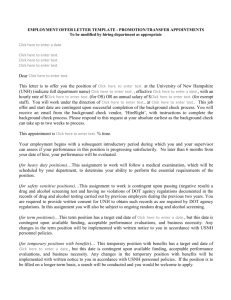2004-Fez conference on Differential Equations and Mechanics
advertisement

2004-Fez conference on Differential Equations and Mechanics
Electronic Journal of Differential Equations, Conference 11, 2004, pp. 41–51.
ISSN: 1072-6691. URL: http://ejde.math.txstate.edu or http://ejde.math.unt.edu
ftp ejde.math.txstate.edu (login: ftp)
NUMERICAL ANALYSIS OF EULER-SUPG MODIFIED
METHOD FOR TRANSIENT VISCOELASTIC FLOW
MOHAMMED BENSAADA, DRISS ESSELAOUI
Abstract. We study a new approximation scheme of transient viscoelastic fluid flow obeying an Oldroyd-B type constitutive law. The approximation stress, velocity, pressure are respectively P1 -continuous, P2 -continuous,
P1 -continuous. We use the modified streamline upwinding Petrov-Galerkin
method induced by the modified Euler method. We assume that the continuous problem admits a sufficiently smooth and sufficiently small solution. We
show that the approximate problem has a solution and we give an error bound.
1. Introduction and Presentation of the problem
In the numerical simulation of the viscoelastic fluid flows, the hyperbolic character of the constitutive equation (when using differential models) has to be taken
into account (see [8, 13]). This hyperbolic character implies that some upwinding
is needed to avoid oscillations as in the method of characteristics [8, 2], the LesaintRaviart discontinuous finite element method [1, 5], the streamline-upwind method
(SU) and the streamline-upwind-Petrov-Galerkin method (SUPG) [6, 13]. The numerical analysis of the steady case of the viscoelastics fluids flows is abundant.
Although the list is not exhaustive, one may see for example [1, 6, 15]. Moreover
the numerical analysis for transient viscoelastic flow remain quite few [11, 16]. For
example, some difficulties appear, when we use continuous finite element approximation for (σ, u, p) and the standard SUPG method for the convection of the extra
stress tensor. To give some response to this difficulties, we develop in this paper the
study of continuous finite element(F.E) approximation of a transient viscoelastic
fluid flow obeying an Oldroyd-B model. For the convective term of the constitutive
equation we use some modified SUPG method linked to a variant of implicit Euler
method (see [3]). Under this condition we are able to show that the approximate
problem is stabilized and has a solution and we give an error bound.
The transient viscoelastic fluid flow obeying an Oldroyd-B type constitutive law
is considered flowing in a bounded, connected open set Ω in IR2 with lipshitzian
2000 Mathematics Subject Classification. 65N30, 34K25, 74S05.
Key words and phrases. Stabilized method; finite elements; modified SUPG method;
transient viscoelastic flow.
c
2004
Texas State University - San Marcos.
Published October 15, 2004.
Supported by CNRST - CNRS, Program STIC01/03, and by CNRST- GRICES Portugal.
41
42
M. BENSAADA, D. ESSELAOUI
EJDE/CONF/11
boundary Γ; n is the outward unit normal to Γ. The basic set of equations of the
Oldroyd-B model with a single relaxation time is given by
∂σ
+ (u.∇)σ + β(σ, ∇u)) + σ − 2αD(u) = 0 in Ω×]0, T [,
∂t
∂u
Re
− ∇.σ − 2(1 − α)∇.D(u) + ∇p = f in Ω×]0, T [,
∂t
∇.u = 0 in Ω×]0, T [,
λ(
(1.1)
u = 0 on Γ×]0, T [,
u = u0 , σ = σ0 in Ω t = 0.
Where λ > 0, Re and 0 < α < 1 are respectively the Weissenberg number, the
Reynolds number and the viscosity ratio constant. f is a density of forces. D(u) =
1
>
>
2 (∇u + ∇u ) the rate of strain tensor, and β(σ, ∇u) = −∇uσ − σ∇u .
Remark 1.1. The boundary condition u = 0 on Γ can be replaced by u = ud on
Γ. Regarding σ and the hyperbolic character of the constitutive equation, we have
to impose σ = σd on Γ− = {x ∈ Γ; ud .n(x) < 0}.
Remark 1.2. The inertia term (u.∇)u is neglected in the momentum equation in
order to make the analysis simpler.
Let us define the following spaces:
T = {τ = (τij )1≤i,j≤2 : τij = τji ; τij ∈ L2 (Ω); i, j = 1, 2}, X = (H01 (Ω))2
Z
Q = {q ∈ L2 (Ω)/ q dx = 0}, V = {v ∈ X/(q, ∇.v) = 0; ∀q ∈ Q}.
Ω
The norm and scalar product in L2 (Ω) of functions, vectors and tensors are denoted
respectively by | · | and (·, ·); (| · |Γ and (·, ·)Γ in L2 (Γ)); hf, vi will denote the duality
between f ∈ (H −1 (Ω))2 and v ∈ X.
Remark 1.3. Existence results for problem (1.1) are proved in [9]. In order to make
some theoretical analysis of approximate problem of (1.1) we use the regularity
imposed in [9].
2. Description of the approximation scheme
FE approximation. We suppose Ω polygonalSand we consider a triangulation
=h on Ω made of triangles K such that Ω = { K; K ∈ =h } uniformly regular,
∃ν0 , ν1 : ν0 h ≤ hK ≤ ν1 %K where %K is the diameter of the greatest ball included
in K and hmax = maxK∈=h hK .
We use the Taylor-Hood finite element method for approximations in space of
(u, p): P2 -continuous in velocity, P1 -continuous in pressure and we consider P1 continuous approximation of the stresses. The corresponding F E space are:
Xh = {v ∈ X ∩ C 0 (Ω)2 : v|K ∈ P2 (K)2 , ∀K ∈ =h }
Qh = {q ∈ Q ∩ C 0 (Ω) : q|K ∈ P1 (K), ∀K ∈ =h }
Vh = {v ∈ Xh : (q, ∇.v) = 0, ∀q ∈ Qh }.
Th = {τ ∈ T ∩ C 0 (Ω) : τ |K ∈ P1 (K), ∀K ∈ =h } ,
EJDE/CONF/11
NUMERICAL ANALYSIS OF EULER-SUPG METHOD
43
where Pm (K) denotes the space of polynomials of degrees less or equal to m on
K ∈ Th . The term ((u.∇)σ, τ ) is approximated by means of an operator B on
Xh × Th × Th defined by
B(uh , σh ; τh ) = ((uh (t).∇)σh (t), τh ) + δ0 (h, t)((uh (t)∇)σh (t), (uh (t).∇)τ )
+ (1/2)((∇.uh )(t)σ, τ ).
For the steady case you can see [15].
Numerical method. We propose Euler-SUPG modified scheme, implicit in time,
based on the scheme proposed for the transport equation (see [3]). We construct an
approximation of the solution at each time step nk, n = 0, . . . , N in the following
way. We start with u0h = ũ0 : elliptic projection of u0 into Vh , σh0 = σ̃0 : orthogonal
projection of σ0 into Th . Given u0h , . . . , unh ; σh0 , . . . , σhn , because (Xh , Qh ) satisfies the inf sup condition, we look for the solution of the following problem, find
(un+1
, σhn+1 ) ∈ Vh × Th , such that
h
n+1
n
σhu
n ,δ − σhun ,δ
h
, τunh ,λ ) + (σhn+1 , τunh ,λ ) + B(λunh , σhn+1 ; τ )
k
− 2α(D(un+1
), τunh ,λ ) + λ(β(σhn+ , ∇un+1
), τunh ,λ ) = 0 ∀τ ∈ Th ;
h
h
λ(
h
un+1
− unh
h
, v) + (σhn+1 , D(v)) + 2(1 − α))(D(un+1
), D(v))
h
k
= hf (tn+1 , x), vi ∀v ∈ Vh ,
Re(
(2.1)
(2.2)
i
i
n
i
n
where σhu
n ,δ = σh + δ(h, k)(uh .∇)σh (i = n, n + 1); τun ,λ = τ + λδ0 (h, k)(uh .∇)τ
h
h
for all τ ∈ Th , and δ(, ) (resp. δ0 (, )) will be specified later. In order to show that
equation (2.1) − (2.2) defined uniquely (un+1
, σhn+1 ), we multiply equation (2.2) by
h
2α and add the equation obtained to equation (2.1), we get
n+1
n
σhu
n ,δ − σhun ,δ
un+1
− unh
h
, vh ) + B(λunh , σhn+1 ; τh )
k
k
+ A(unh ; (σhn+1 , un+1
), (τ, v)) + λ(β(σhn+1 , ∇un+1
), τunh ,λ )
h
h
λ(
h
h
, τunh ,λ ) + 2αRe(
= 2αhf (tn+1 ), vh i ,
∀(τh , vh ) ∈ Th × Vh .
where A(., .) is a bilinear form on Th × Vh defined as
A(w; (σ, u), (τ, v)) = (σ, τw,λ )+2α(σ, D(v))−2α(D(u), τw,λ )+4α(1−α)(D(u), D(v))
From this, we can establish some error bound and then the following existence
result
Theorem 2.1. There exists M0 , and h0 such that if problem (1.1) admits a solution
(σ, u, p) with,
M = max kσkC 1 ([tn ,tn+1 ];H 2 ) , kukC 1 ([tn ,tn+1 ];H 3 ) , kpkC 0 ([tn ,tn+1 ];H 2 ) ,
kσkC 2 ([tn ,tn+1 ];L2 ) , kukC 2 ([tn ,tn+1 ],T ;L2 ) < M0 ,
then if δ(, ) satisfies δ(, ) = λδ0 (, ) and h ≤ h0 there exists a unique solution in
Th × Vh of problem (2.1)- (2.2).
Proof. For this purpose we define a mapping Φ : Th × Vh 7−→ Th × Vh , which to
(σ1 , u1 ) associates (σ2 , u2 ) = Φ(σ1 , u1 ), where (σ2 , u2 ) ∈ Th × Vh satisfies
n
σ2unh ,δ − σhu
n ,δ
u2 − unh
h
λ(
, τunh ,λ ) + 2αRe(
, vh ) + B(λunh , σhn+1 ; τh )
k
k
44
M. BENSAADA, D. ESSELAOUI
EJDE/CONF/11
+ A(unh ; (σ2 , u2 ), (τ, v))
= −λ(β(σ1 , ∇u1 ), τunh ,λ ) + 2αhf (tn+1 ), vh i ,
(n+1)
We define a ball Bh
(n+1)
Bh
∀(τh , vh ) ∈ Th × Vh .
as follows: let C ∗ be given. Then we define
αRe
= (τh , vh ) ∈ Th × Vh : [
kvh − u(tn+1 )k20,Ω
k
p
3
λ
h2
+
k(τh − σ(tn+1 ))unh ,λ k20,Ω ]1/2 ≤ C ∗ (k + δ + h δ0 + √ + h 2 ),
2k
δ0
1
[ {4α(1 − α)kD(vh − u(tn+1 )k20,Ω + kτh − σ(tn+1 )k20,Ω ]1/2
4
p
3 h2
≤ C ∗ (k + δ + h δ0 + √ + h 2 ) .
δ0
The proof is decomposed in five parts:
(a) Φ is well defined for h ≤ h1 = h1 (hmax , α) and bounded on bounded sets,
(b) let C0 be a positive constant independent of h, k and λ, α, Re. If h ≤ h0 =
p
√
2/3 1 p
∗
(n+1)
is non, C0 M k/λ and δ/k ≤ C01M , we have Bh
min h1 , k C MC√αRe
0
p
∗ γ
empty. On the other hand, if M0 = C λ+γ , γ = α(1 − α), we can prove that
◦
◦
z}|{(n+1)
z}|{(n+1)
Φ( B h
)⊂ B h
,
(n+1)
(n+1)
(c) Φ is continuous on Th × Vh . Φ(Bh
) ⊂ Bh
, Brouwer’s theorem then gives
n+1
n+1
the existence of fixed point (σh , uh ) of Φ solution of problem (1) − (2).
(d) Furthermore, if λM and λM γ −1 is sufficiently small, Φ is a contraction mapping
(n+1)
on Bh
.
Then a result of existence and uniqueness follows from the fixed theorem.
Remark 2.2. When we use only the classical Euler-scheme in time and SUPG
method, we can’t point out result of (a) in the above proof.
3. Main result and error estimates
Suppose that the continuous problem admits a sufficiently smooth and sufficiently small solution, we can show, the following result.
Theorem 3.1. There exists M0 and h0 such that if problem (1.1) admits a solution (σ, u, p) with σ ∈ C 1 ([0, T ], (H 2 )4 ) ∩ C 2 ([0, T ], (L2 )4 ); u ∈ C 1 ([0, T ], (H 3 )2 ) ∩
C 2 ([0, T ], (L2 )2 ); p ∈ L2 ([0, T ], (H 2 ) ∩ L20 ) ∩ C 0 ([0, T ], H 2 ), satisfying
max{kσkC 1 (0,T ;H 2 ) , kukC 1 (0,T ;H 3 ) , kpkC 0 (0,T ;H 2 ) , kσkC 2 (0,T ;L2 ) , kukC 2 (0,T ;L2 ) } ≤ M0
then for kh−(1+ε) (0 < ε ≤ 1/2) bounded, there exists a constant C independent of
h and k such that
max |(σhn −σ(tn ))un−1 |+(
0≤n≤N
N
X
h
k|σhn −σ(tn )|)2 )1/2 ≤ C(k +δ +h
p
n=0
h2
δ0 + √ +h1+ε )
δ0
and
max |unh − u(tn )| + (
0≤n≤N
N
X
n=0
k|D(unh − u(tn ))|2 )1/2 ≤ C(k + δ + h
h2
δ0 + √ + h1+ε )
δ0
p
EJDE/CONF/11
NUMERICAL ANALYSIS OF EULER-SUPG METHOD
45
0
i
i
where N ∈ N ∗ : N k = T , u−1
h = uh and (σh , uh )1≤i≤N are solutions of ((2.1) −
(2.2))1≤i≤N .
Remark 3.2. The discontinuous stresses approach case with Euler semi-implicit
method in time was treated by Baranger and all. [16]. In the proof of the present
result we can fund some similar technical like in [16].
Proof of Theorem 3.1. For 0 ≤ n < N , let u(tn ), σ(tn ), p(tn ) be respectively in
H 3 (Ω), 2 (Ω), H 2 (Ω) and so, there exists (ũ(tn ), p̃(tn )) ∈ Vh × Qh such that,
|(u − ũ)(tn )| + hk(u − ũ)(tn )k1,2 ≤ C1 h3 ku(tn )k3,2 ,
2
|(p − p̃)(tn )| ≤ C2 h kp(tn )k2,2 ,
(3.1)
(3.2)
(see [10]) and there exists σ̃(tn ) ∈ Th such that
|(σ − σ̃)(tn )| ≤ C3 h2 kσ(tn )k2,2
(3.3)
(see [10]). We remark that we can define ũ(.) by the elliptic projection of u(.) on
Vh such that a((u − ũ)(.), vh ) = 0, ∀vh ∈ Vh , where a(u, v) = (d(u), d(v)); then the
following properties are also satisfied
dũ/dt = (du/dt)∼
and
|(du/dt)(s) − (du/dt)∼ (s)| ≤ C4 hk(du/dt)(s) − (du/dt)∼ (s)k1,2
≤ C5 h3 k(du/dt)(s)k3,2
(3.4)
(see([14])), u being in C 1 ([0, T ], H 3 ); same properties are satisfied for σ:
dσ̃/dt = (dσ/dt)∼
and
|
˜
˜
dσ
dσ
dσ
dσ
dσ
(s) −
(s)| ≤ C6 hk (s) −
(s)k1,2 ≤ C7 h2 k (s)k2,2 ,
dt
dt
dt
dt
dt
(see([14])).
(3.5)
In the sequel we shall use the following inverse inequalities (see [4]).
Lemma 3.3. Let k ≥ 0 be an integer and Wh = {v, v|K ∈ Pk (K) ∀K ∈ =h }.
Let r and p be reals with 1 ≤ r, p ≤ ∞ and let l ≥ 0 and m ≥ 0 be integers
such that l ≤ m. Then there exists a constant C = C(ν0 , ν1 , l, r, m, p, k) such that
∀v ∈ Wh ∩ W l,r (Ω) ∩ W m,p (Ω), |v|m,p ≤ Chl−m−2 max{0,1/r−1/p} |v|l,r .
We shall also use the following Sobolev’s imbedding theorems.
Lemma 3.4. Let m ≥ 0 be an integer. The following embedding hold algebraically
and topologically:
W m+1,2 (Ω) ⊂ W m,q (Ω) ∀q ∈ [1, ∞[,
and
W m,p (Ω) ⊂ C 0 (Ω̄).
46
M. BENSAADA, D. ESSELAOUI
EJDE/CONF/11
Now, let us denote enh = unh − ũ(tn ), εnh = σhn − σ̃(tn ). From equations (2.1)-(2.2)
we have for (τ, v) ∈ Th × Vh
n+1
n
εhun ,δ − εhun ,δ
en+1 − enh )
h
h
2αRe( h
, v) + λ(
, τunh ,λ ) + B(λunh , εn+1
; τ)
h
k
k
n+1 n+1
n
+ A(uh ; (εh , eh ), (τ, v))
σ̃hunh ,δ (tn+1 ) − σ̃hunh ,δ (tn )
ũ(tn+1 ) − ũ(tn )
, τunh ,λ ) − 2αe(
, v)
k
k
− B(λunh , σ̃(tn+1 ); τ ) + A(unh ; (−σ̃(tn+1 ), −ũ(tn+1 )), (τ, v))
= −λ(
− λ(β(σhn , ∇unh ), τunh ,λ ) + 2αhf (tn+1 , x), vi,
(3.6)
∀(τ, v) ∈ Th × Vh .
But (σ, u, p) being the exact solution of problem (1.1), it satisfies the following
consistency equation
du
dσ
2αRe( (t), v) + λ( (t), τunh ,λ ) + B(λu(t), λunh , σ(t); τ )
dt
dt
+ A(unh ; (σ(t), u(t)), (τ, v))
= 2α(p(t), ∇.v) + 2αhf (t), vi − λ(β(σ(t), ∇u(t)), τunh ,λ ) ∀(τ, v) ∈ Th × Vh
Inserting the value of hf (tn+1 ), .i in equation (3.6) we obtain
n+1
n
εhun ,δ − εhun ,δ
en+1 − enh )
h
h
, v) + λ(
, τunh ,λ ) + B(λunh , εn+1
; τ)
Re( h
h
k
k
n+1
n+1
+ A(unh ; (εh , eh ), (τ, v))
= λ(ga (σ(tn+1 ), ∇u(tn+1 )) − ga (σhn , ∇unh ), τ )
du
ũ(tn+1 ) − ũ(tn )
(tn+1 ) −
, v)
dt
k
σ̃un (tn+1 ) − σ̃unh (tn )
dσ
, τunh ,λ )
+ λ( (tn+1 ) − h
dt
k
+ A(unh , ((σ − σ̃)(tn+1 ), (u − ũ)(tn+1 )), (τ, v))
+ 2αRe(
+ λ[B(λu(tn+1 ), λunh , σ(tn+1 ); τ ) − B(λunh , σ̃(tn+1 ); τ )] + 2α(p(tn+1 ), ∇.v).
(3.7)
n+1
Taking v = en+1
and
τ
=
ε
in
equation
(3.7)
and
using
the
identity
(a
−
b,
a) =
h
h
1
2
2
2
(|a|
−
|b|
+
|a
−
b|
),
and
coercivity,
we
obtain
2
αRe n+1 2
{|eh | − |enh |2 + |en+1
− enh |2 } + |εn+1
|2
h
h
k
λ
+
{|εn+1
|2 − |εnhunh ,λ |2 + |εn+1
− εnhunh ,λ |2 }
n
hun
h ,λ
2k huh ,λ
+ 2α(1 − α)|D(en+1
)|2 + (1/2)|εn+1
|2 + (δ0 /4)|λunh .∇εn+1
|2
h
h
h
(3.8)
which is less than ro equal to the right-hand side of (3.7). To bound each term of
m
the second member of inequality (3.8), let us define for C0 > 0, the ball Bh,k
for
0 ≤ m ≤ N , by
m
Bh,k
= (τi , vi )i=0,..,m ∈ (Th × Vh )m+1 : max {|(τi − σ(ti ))vi−1 |2 + |vi − u(ti )|2 }1/2
0≤i≤m
≤ C0 (k + δ + h
p
2
h
δ0 + √ + h1+ε ) and
δ0
EJDE/CONF/11
[
m
X
NUMERICAL ANALYSIS OF EULER-SUPG METHOD
k{|τi − σ(ti )|2 + |D(vi − u(ti ))|2 }]1/2 ≤ C0 (k + δ + h
47
h2
δ0 + √ + h1+ε ) .
δ0
p
n=0
Our aim is to prove that we can choose M0 , h0 , C0 such that for M ≤ M0 , h ≤ h0
m−1
m
if (σhn , unh )0≤n≤m−1 ∈ Bh,k
for a C0 = C0 (M0 , h0 , Ci ) then (σhn , unh )0≤n≤m ∈ Bh,k
for the same C0 , thus for all m such mk ≤ T . Firstly, by equations (3.1) to (3.5)
we have
|(σh0 − σ(0))u0h | + |u0h − u(0)| ≤ M h2 {C3 (1 + λM δ0 h−1 ) + C1 }
and
[k{|σh0 − σ(0)|2 + |D(u0h − u(0)|2 }]1/2 ≤
√
2k(C1 + C3 )M h2 .
0
To ensure that (σh0 , u0h ) = (σ̃0 , ũ0 ) ∈ Bh,k
, it suffices to impose, for h < h1 ,
M h1/2 {C3 (1 + λM δ0 h−1 ) + C1 } ≤ C0
and for h ≤ h2 ,
p
3−ε
(C1 + C3 ) 2C̄M h 2 ≤ C0 .
So, if we take h0 ≤ min{h1 , h2 } we have for h ≤ h0 : Bh0 6= ∅. Now, let us suppose
(m−1)
that (σhn , unh )0≤n≤m−1 ∈ Bh,k . We multiply inequality (3.8) by k and sum it for
n = 0 to n = m − 1,
αRe
m−1
X
[|en+1
|2 − |enh |2 + |en+1
− enh |2 ] + (1/2)
h
h
n=0
+
λ
2
m−1
X
m−1
X
k|εn+1
|2
h
n=0
2
n
n
[|εn+1
| + |εn+1
|2 ] + 2α(1 − α)
hun ,λ | − |εhun
hun ,λ − εhun
h ,λ
h ,λ
h
h
n=0
+ (δ0 /4)
m−1
X
k|D(en+1
)|2
h
n=0
m−1
X
k|λunh .∇εn+1
|2
h
n=0
≤λ
m−1
X
k(ga (σ(tn+1 ), ∇u(tn+1 )) − ga (σhn+1 , ∇un+1
), εn+1
h
hun ,λ )
(3.9)
h
n=0
+λ
m−1
X
k(
n=0
+ 2αRe
σ̃un ,δ (tn+1 ) − σ̃unh ,δ (tn ) n+1
dσ
(tn+1 ) − h
, εhun ,λ )
h
dt
k
m−1
X
n=0
+
m−1
X
k(
du
ũ(tn+1 ) − ũ(tn ) n+1
(tn+1 ) −
, eh )
dt
k
kA(unh ; (σ − σ̃)(tn+1 ), (u − ũ)(tn+1 ), (εn+1
, en+1
))
h
h
(3.10)
(3.11)
(3.12)
n=0
+λ
m−1
X
k{B(λu(tn+1 ), λunh , σ(tn+1 ); εn+1
) − B(λunh , σ̃(tn+1 ); εn+1
)}
h
h
(3.13)
n=0
+ 2α
m−1
X
k(p(tn+1 ), ∇.en+1
).
h
(3.14)
n=0
We use for the estimate of terms (3.11)–(3.14), the results (3.1)–(3.5). However, for
the estimation of the term (3.9) we choose the fixed point (σhm , um
h ) of the mapping
48
M. BENSAADA, D. ESSELAOUI
EJDE/CONF/11
(0)
0
Φ defined in section 2. This choice is possible because we have, Bh ∩ Bh,∆t
6= ∅
and by construction:
(m−1)
m−1
(σhl , ulh )l=0;..;m−1 ∈ Bh,∆t
⇒ (σhm−1 , um−1
) ∈ Bh
h
.
On the other hand for estimate of the term (3.10) we prepare the following lemma:
Lemma 3.5. Let (3.1)–(3.5) hold. Then
|(
σ̃un ,δ (tn+1 ) − σ̃unh ,δ (tn ) n+1
dσ
(tn+1 ) − h
, εhun ,λ )|
h
dt
k
m−1
X
3
2
2
≤ λM [C7 h + k + δM C10 (M + hM + C1 M h )](
k)1/2
n=0
max
0≤n≤m−1
|εn+1
hun ,λ )|
h
m−1
X
+ δM [C7 C8 kh(
k|∇(unh − u(tn ))|2 )1/2
n=0
+ (C7 λ−1 h2 +
m−1
X
C7
C9 δ0 (M + max |u(tn ) − unh |))]
k)1/2
0≤n≤m−1
C6
n=0
m−1
X
p
1/2 −1
+ λ(1 + δ0 )δh (
k|∇(unh − u(tn ))|2
n=0
×
m−1
X
n+1 2
2
n
k{|εn+1
| }
hun ,λ | + δ0 |λ(uh .∇)εh
1/2
.
h
n=0
Proof. To proof the inequality in this lemma, we write each term as follows:
σ̃un ,δ (tn+1 ) − σ̃unh ,δ (tn )
dσ
(tn+1 ) − h
dt
k
σunh ,δ (tn+1 ) − σunh ,δ (tn ) dσ
=
(tn+1 ) −
dt
k
σunh ,δ (tn+1 ) − σunh ,δ (tn ) σ̃unh ,δ (tn+1 ) − σ̃unh ,δ (tn ) −
+
k
k
we can write the second term in the form,
Z tn+1
Z tn+1
˜
˜
1
dσ
dσ
δ
dσ
dσ
(
(
− ( ))(s) ds, εn+1
)
+
(
unh .∇(
− ( ))(s) ds, εn+1
)
hun
,λ
hun
h
h ,λ
k tn
dt
dt
k tn
dt
dt
so,
σunh ,δ (tn+1 ) − σunh ,δ (tn+1 ) σ̃unh ,δ (tn+1 ) − σ̃unh ,δ (tn+1 ) n+1
−
, εhun ,λ )|
h
k
k
Z tn+1
Z tn+1
˜
˜
dσ
dσ
dσ
dσ
≤ |(
(
− ( ))(s) ds, εn+1
unh .∇(
− ( ))(s) ds, εn+1
)|
hun
,λ )| + δ|(
hun
h
h ,λ
dt
dt
dt
dt
tn
tn
|k(
we estimate the first term in this inequality using (3.5):
Z tn+1
˜
˜
dσ
dσ
dσ
dσ
|(
(
− ( ))(s) ds, εn+1
max |(
− ( ))(s)||εn+1
|
hun
,λ )| ≤ k t ≤s≤t
hun
h
h ,λ
dt
dt
dt
dt
n
n+1
tn
≤ C7 M kh2 |εn+1
hun ,λ |.
h
EJDE/CONF/11
NUMERICAL ANALYSIS OF EULER-SUPG METHOD
49
To study the second term, we write
Z tn+1
˜
dσ
dσ
(
unh .∇(
− ( ))(s) ds, εn+1
)
hun
h ,λ
dt
dt
tn
Z tn+1
˜
dσ
dσ
− ( ))(s) ds, (unh .∇)εn+1
)
= −(
(
h
dt
dt
tn
Z tn+1
˜
dσ
dσ
n
+ ((∇.uh )
(
− ( ))(s) ds, εn+1
)
h
dt
dt
tn
Z tn+1
˜
dσ
dσ
− ( ))(s) ds, λ(unh .∇)εn+1
)
+ δ0 (
unh .∇(
hun
h ,λ
dt
dt
tn
and
˜
dσ
dσ
− ( ))(s) ds, εn+1
)|
hun
h ,λ
dt
dt
tn
˜
dσ
dσ
≤ δλ−1 k max |(
− ( ))(s)||λ(unh .∇)εn+1
|
h
tn ≤s≤tn+1
dt
dt
˜
dσ
dσ
+ δk max |(
− ( ))(s)||∇(unh − u(tn ))||εn+1
|0,∞
h
tn ≤s≤tn+1
dt
dt
˜
dσ
dσ
+ kδ0 δ|unh |0,∞ max |(
− ( ))(s)|1,2 |λ(unh .∇)εn+1
|
h
tn ≤s≤tn+1
dt
dt
Z
δ|(
tn+1
unh .∇(
using (3.5) and the result of Lemma 3.3, we obtain the following estimate
Z tn+1
˜
dσ
dσ
δ|(
unh .∇(
− ( ))(s) ds, εn+1
)|
hun
h ,λ
dt
dt
tn
≤ δC8 C7 M δkh|∇(unh − u(tn ))||εn+1
|
h
C7
+ {δλ−1 C7 M h2 + C9
M hδ0 δh−1 |unh |}k|λ(unh .∇)εn+1
|
h
C6
≤ C7 C8 M δkh|∇(unh − u(tn ))|εn+1
|
h
2
p
h
C7
+ C7 δλ−1 M √ + C9
M δ δ0 (M + max |unh − u(tn )|)
0≤n≤m−1
C6
δ0
p
n+1
n
× δ0 |λ(uh .∇)εh |
and finally
σunh ,δ (tn+1 ) − σunh ,δ (tn+1 ) σu∼nh ,δ (tn+1 ) − σu∼nh ,δ (tn+1 ) n+1
λ|
k(
−
, εhun ,λ )|
h
k
k
n=0
m−1
X
m−1
X
≤ λC7 M h2 (
k)
n=0
max
0≤n≤m−1
m−1
X
+ λC7 C8 M δkh(
n=0
2
|εn+1
hun ,λ |
h
m−1
X
k|∇(unh − u(tn ))|2 )1/2 (
k|εn+1
|2 )1/2
h
n=0
h
C7 p
+ δM {C7 λ−1 √ +
C9 δ0 (M + max |unh − u(tn )|))}
0≤n≤m−1
C6
δ0
(3.15)
50
M. BENSAADA, D. ESSELAOUI
m−1
X
×(
m−1
X
k)1/2 (
n=0
EJDE/CONF/11
kδ0 |λunh .∇εn+1
|2 )1/2 .
h
n=0
Now, we return to the first part of term (3.10).
σun ,δ (tn+1 ) − σunh ,δ (tn ) n+1
dσ
(tn+1 ) − h
, εhun ,λ )|
h
dt
k
dσ
σ(tn+1 ) − σ(tn ) n+1
≤ |k( (tn+1 ) −
, εhun ,λ )| + δ|(unh .∇(σ(tn+1 ) − σ(tn )), εn+1
)|
hun
h
h ,λ
dt
k
Z tn+1
Z
tn+1
dσ
d2 σ
≤ |(
(s − t) 2 (s) ds, εn+1
)| + δ|(
unh .∇ (s) ds, εn+1
)|
hun
,λ
hun
h
h ,λ
dt
dt
tn
tn
|k(
≤ k2
max
tn ≤s≤tn+1
|
d2 σ
dσ
(s)||εn+1
| + δk|unh |0,∞ max | (s)|1,2 |εn+1
|.
hun
hun
h ,λ
h ,λ
tn ≤s≤tn+1 dt
dt2
Using the regularity of σ, we have
|k(
σun ,δ (tn+1 ) − σunh ,δ (tn ) n+1
dσ
(tn+1 ) − h
, εhun ,λ )| ≤ M (k 2 + kδ|unh |0,∞ )|εn+1
|.
hun
h
h ,λ
dt
k
On the other hand, by the imbedding result W 1,4 ⊂ L∞ (see Lemma 3.3) and the
−1
inverse inequality result | · |0,∞ ≤ C10 h 2 | · |0,4 (see Lemma 3.4) we can prove,
3
1
|unh |0,∞ ≤ C10 (M + hkuk3,2 + C1 M h 2 + h− 2 |∇(u(tn ) − unh )|).
So we have,
λ|
m−1
X
n=0
k(
σun ,δ (tn+1 ) − σunh ,δ (tn ) n+1
dσ
(tn+1 ) − h
, εhun ,λ )|
h
dt
k
3
m−1
X
≤ λM [k + δM C10 (M + hM + C1 M h 2 )](
k) ×
n=0
+ λ(1 +
max
0≤n≤m−1
|εn+1
hun ,λ |
h
m−1
X
p
1/2
1
δ0 )δh− 2
k|∇(u(tn ) − unh )|2
n=0
m−1
X
X
m−1
2 1/2
× (
k|εn+1
|
)
+
(
kδ0 |λunh .∇εn+1
|2 )1/2 .
h
h
n=0
n=0
Then Lemma 3.5 follows from the above inequality and (3.15).
Conclusion. We conclude this analysis with some comments. The proof given here
can be extended to the more realistic rheological PTT model, to a quadrilateral FE
approximation, following [1] and to the higher finite element methods(Pk , k ≥ 1).
With a judicious coefficient choice of stabilization δ and δ0 , we find the error bound
given respectively by Baranger and al. [16] and Ervin and al. [7].
The use of a decoupled fractional step scheme would be computationally cheaper,
following [6]. Numerical analysis of such method is currently in progress.
EJDE/CONF/11
NUMERICAL ANALYSIS OF EULER-SUPG METHOD
51
References
[1] A. Bahar, J. Baranger, D. Sandri , Galerkin discontinuous approximation of the transport
equation and viscoelastic fluid flow on Quadrilateral, Numer. Meth. Partial Diff. Equations,
14(1)(1998), 97-114.
[2] F. G. Basambrio , Flows in viscoelastic fluids treated by the method of characteristics, JNNFM
39 (1991), 17-34.
[3] M. Bensaada, D. Esselaoui, Stabilization method for continuous approximation of transient
convection problem, In press: Numer. Methods for Partial Differential Equations, (2004).
[4] P. G. Ciarlet, The finite element method for elliptic problems, North-Holland, Amsterdam,
(1978).
[5] D. Esselaoui, K. Najib, A. Ramadane, A. Zine, Analyse numérique et approche découplée d’un
problème d’écoulements de fluides non newtoniens de type Phan-Thien-Tanner:contraintes
discontinues, C.R. Acad. Sci. Paris série I (2000), 931-936.
[6] D. Esselaoui, A. Ramadane, A. Zine, Decoupled approch for the problem of viscoelastic fluid
flow of PTT model I: continuous stresses, Compt. Methods Appl. Mech. Engrg. (2000), 543560.
[7] V. J. Ervin and W. W. Miles, Approximation of time-dependent viscoelastic fluid flow: SUPG
Approximation, SIAM J. Numer. Anal. 41 N0. 2 (2003) 457-486.
[8] M. Fortin, D. Esselaoui, A finite element procedure for viscoelastic flows. Int. J. Num. Meth.
Fluids, 7 (1987), 1035-1052.
[9] C. Guillopé, J.C. Saut, Résultats d’existence pour des fluides viscoélastiques à lois de comportements de type différentiel, Nonlinear Analysis Theory, methods and Applications, 15
(1990), 849-869.
[10] V. Girault, P.A. Raviart, Finite element method for Navier-Stokes equation theory and algorithms, Springer, Berlin, (1986).
[11] R. A. Keiller, Numerical instability of time dependant flows. JNNFM 43 (1992), 229-246.
[12] V. Legat, M.J. Crochet, The consistent streamline upwind/Petrov-Galerkin method for viscoelastic flow recisited. In Problèmes non-linéaires appliqués. CEA. INRIA. EDF, (1992).
[13] M.J. Marchal, M.J. Crochet, A new finite element for calculating viscoelastic flows, J. N?.
N?. F?. M?, 26 (1987), 77-114.
[14] P.A. Raviart, J.M. Thomas, Introduction à l’analyse numérique des E.D.P., MASSON, Paris,
(1983).
[15] D. Sandri, Finite approximation of viscoelastic fluid flow: existence of approximate solutions
and error bounds, continuous approximation of the stress. SIAM J. Numer. Anal., 31 (1994),
362-377.
[16] S. Wardi, J. Baranger, Numerical analysis of a FEM for a transient viscoelastic flow. Comput.
Methods Appl. Mech. Engr. 125 (1995), 171-185.
Mohammed Bensaada
Laboratoire des Sciences de l’Ingénieur, Analyse Numérique et Optimisation (SIANO),
Faculté des Sciences, Université Ibn Tofail, B.P.133, 14000-Kénitra, Maroc
Driss Esselaoui
Laboratoire des Sciences de l’Ingénieur, Analyse Numérique et Optimisation (SIANO),
Faculté des Sciences, Université Ibn Tofail, B.P.133, 14000-Kénitra, Maroc
E-mail address: desselaoui@yahoo.fr Fax: 212 37 37 27 70





